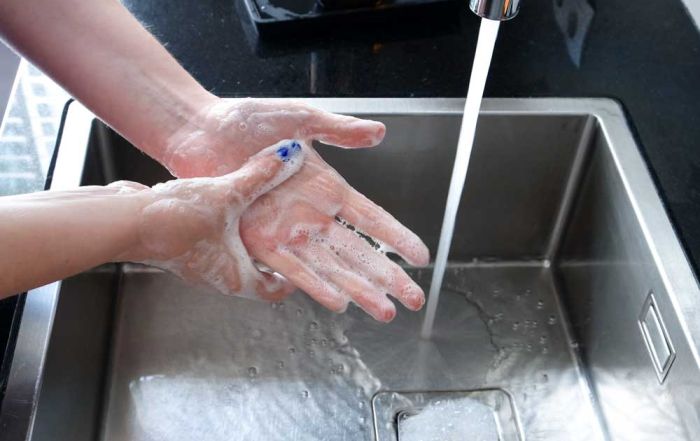Never Did I Ever…
Yes, I know the real game is “never have I ever”, but that phrase didn’t work for the topic of this blog, so I changed it around a bit. I was working on a presentation earlier in the week on hand hygiene and I started thinking back to my career in foodservice. As someone who has spent years in the foodservice industry, I’ve come to appreciate the importance of hand hygiene and safety measures, including the use of gloves. But I do recall when no bare hand contact became a “rule” that we had to follow. It had to be the mid- to late-1990s, as I recall. I am sure there are those of you reading this who will know the exact date, but it isn’t something I committed to memory. I know I was just beginning my career at the time and was likely a cook, and I was adamantly against gloves. As I was thinking back to that time, never did I ever….think I would be a proponent of glove use and the no bare hand contact guidelines in the food code.
When the no bare hand contact rule first came out, I had a long list of reasons I was against the use of gloves. I could go on and on, but there were four main issues I had. First, there was a common misconception with my fellow employees that wearing gloves automatically ensures food safety. While I was certainly new to foodservice, I had enough food safety training through 4-H and other avenues to know that gloves were not the be-all and end-all solution. Clean hands and proper sanitation seemed sufficient to prevent contamination. Second, I thought gloves would inhibit my ability to know when my hands were truly “contaminated” (yes, I was young, it was a silly notion). Even back then, I was adamant about handwashing, but now I realize that I was likely not the norm. Third, the gloves we first used were not comfortable to wear. And last, but not least, I am sure there was a little bit of resistance to change (ok…maybe a lot of resistance to change!).
It’s a topic that I never thought would become a significant part of my future career, but experience has shown me the important role gloves play in maintaining food safety and customer health.
As I delved deeper into food safety throughout my career, I have come to realize that while handwashing is crucial, it may not always be enough, especially in busy kitchen environments. The use of gloves is not just about personal hygiene; it’s also a preventive measure against cross-contamination. When handling raw ingredients, including meat, poultry, and seafood, gloves act as a barrier, reducing the risk of pathogens spreading to other foods or surfaces. What I used to believe was that when I touched raw chicken, I would remember to wash them after working with it because I could feel it on my hands. I feared that gloves would remove this tactile cue to wash my hands and thus lead to increased chances of cross contamination. What I wasn’t considering then was that gloves helped to protect my hands in several ways, for example, helping to prevent bacteria from getting under my fingernails, or in between my fingers, areas where I may not wash as thoroughly and thus might lead to cross contamination. The glove “barrier” is particularly important in establishments where multiple dishes are prepared simultaneously.
Today, gloves have almost been a visual cue to the dining public about the commitment to food safety… instilling confidence and trust in the cleanliness of the kitchen and the safety of the food being served.
Gloves play a role in maintaining the quality and integrity of food products. Touching food with bare hands can transfer oils, sweat, and other contaminants, altering the taste and texture of dishes. Gloves help preserve the natural flavors and appearance of ingredients, contributing to a more enjoyable dining experience for customers.
I was right back then about the fact that gloves can give a false sense of security to employees and that employees might practice improper glove use. Thus, it is vital that we train our employees in the proper use of gloves and the use of handwashing when wearing gloves.
Glove design and technology have also come a long way since the days when they were first required. One of my main concerns with the first batch of loose-fitting gloves we ordered at the restaurant was the ability to actually work in them and be productive without fighting with them the entire time I had them on. FoodHandler’s gloves, including the newer ThinSense™ nitrile gloves, give employees the tactile sensitivity, strength, and durability that would have been unimaginable 25 years ago.
Today, gloves have almost become a visual cue to the dining public about the commitment to food safety an operation may have. Observing kitchen staff wearing gloves can instill confidence and trust in the cleanliness of the kitchen and the safety of the food being served. It’s a visible symbol of your commitment to food safety practices.
Yes, there was a time when I resisted the idea of wearing gloves on a regular basis. It seemed like an extra step, an unnecessary barrier between me and the food I was preparing. However, with proper training and understanding of the benefits, I came to see gloves as a valuable tool rather than an inconvenience. My journey from skepticism to advocacy for gloves reflects a broader lesson about embracing change for the better. Sometimes, what may seem like a minor adjustment can have significant positive impacts on food safety. Risk Nothing.
READ MORE POSTS
30 Years Later: The Foodborne Illness Outbreak that Changed Food Safety
In January, we hit a major anniversary. One I am betting snuck by many of you – including me! January marked 30 years since the deadly 1993 E. coli O157:H7 outbreak at Jack in the Box restaurants on the west coast. The anniversary wasn’t on any of the major news networks that I recall. It did make it into a few newspapers, at least one or two of the newspapers that are left. It wasn’t until late-February that I realized it.
Does Temperature Really Matter when Washing your Hands?
In January, I reviewed the changes to the 2022 Food Code in my blog (check out Part I and Part II), and one change to the food code that I had mentioned, but didn’t discuss in-depth, was the change that lowered the water temperature a hand sink was required to produce to 85°F, as noted in Section 2-202.12 of the code. This requirement has been in place since the publishing of the 2001 Food Code, which required a water temperature of 100°F. Prior to this, 110°F was required (see the 1999 Food Code). So why the change and does water temperature when washing your hands really matter?
Hand sinks: Often Taken for Granted, but an Essential Part to Effective Hand Hygiene
Late in January, I received a question about hand sinks in a foodservice operation. The question pertained to school staff (teachers and aides) who were using a hand washing sink in the school kitchen. The question came as a matter of who was allowed access to the kitchen to use the sink, but the question itself caused me to go down a rabbit hole of requirements for hand washing sinks in foodservice operations.
Hot off the Press: The 2022 Model Food Code has been Released! Part Two.
Earlier in the month, we started a discussion about the changes to the 2022 Food Code. If you missed that post, late in December 2022, the Food and Drug Administration released the 2022 Food Code and I wanted to highlight a few of the changes that have been made to the code.










